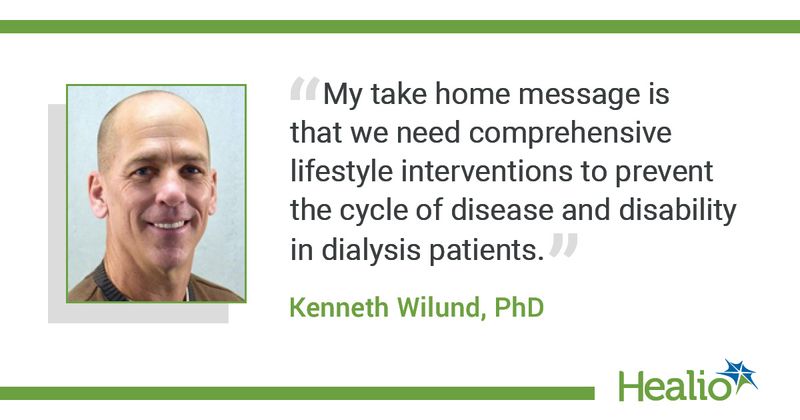Presenter: Novel methods are needed to implement intradialytic exercise
Intradialytic exercise is difficult to implement, but the right methods may yield significant benefits for patients, according to a presenter at the International Conference on Dialysis.
“Most of the existing literature does show modest benefits of exercise, but there are a lot of flaws,” Kenneth Wilund, PhD, from the University of Illinois at Urbana-Champaign, said in the presentation.

Regardless of the type of exercise, patients on hemodialysis who exercise show statistically significant improvements in muscle strength and physical function; however, Wilund said a persistent challenge is getting patients to commit to exercising.
For example, Wilund referenced a study in which 40% of patients on hemodialysis who were screened for an exercise program actually enrolled in the program, and 41% of the exercise group dropped out of the program. Based on the data in this study, 17% of patients on dialysis are likely to finish a 6-to-12-month exercise program.
Similarly, Wilund cited the EXCITE trial in which 30% of the exercise group dropped out before trial completion. The intervention consisted of walking for 60 minutes during the course of a week, otherwise described as walking 20 minutes three times a week. Results revealed that although patients walked an average of 30 minutes a week, half of the prescribed intervention, those who completed the trial experienced a reduction in hospitalizations.
However, Wilund said typical exercise programs, like intradialytic cycling or walking, will not always be enough to have significant benefits for patients on dialysis. In one study he referenced, patients who cycled for 30 minutes a day, three times a week for 6 months did not experience improvements.
“So, what can we do?” Wilund asked. He said potential solutions include larger studies focused on relevant outcomes that may incorporate technology, such as virtual reality or remotely delivered exercise programs.
“My take-home message is that we need comprehensive lifestyle interventions to prevent the cycle of disease and disability in dialysis patients,” Wilund said. “We have to get away from the notion of simple exercise programs.”
Another method is to get patients to move more instead of mandating programs. Wilund discussed one of his studies in which patients create weekly goals for movement, and each week that goal progresses. Wilund and colleagues hope that over time, patients will have created a habitual exercise program at their own pace that leads to significant improvement.
“Is exercise ready for prime time? I think it’s complicated, but in my honest opinion, we’re not quite there yet,” Wilund said. “We know it can work, but we haven’t to date been able to get enough patients to do enough to see robust benefits. We’re on the right track. We have patients around the world, [and we are] getting patients moving more and doing comprehensive interventions. But in my team, we want to see robust benefits that are going to inspire policy and practice changes to make exercise programs a component of the standard care for dialysis patients. We have to implement more comprehensive intervention strategies, and this work is in progress.”
